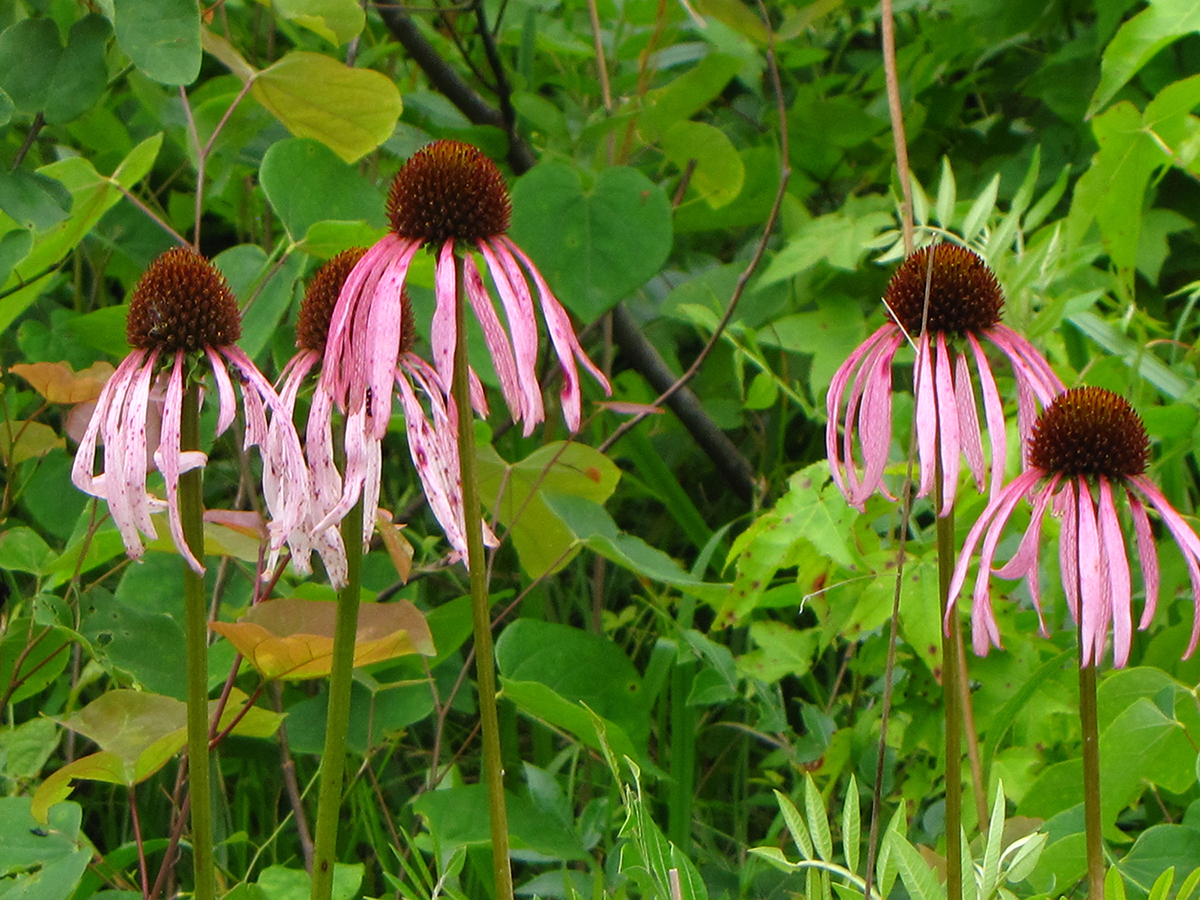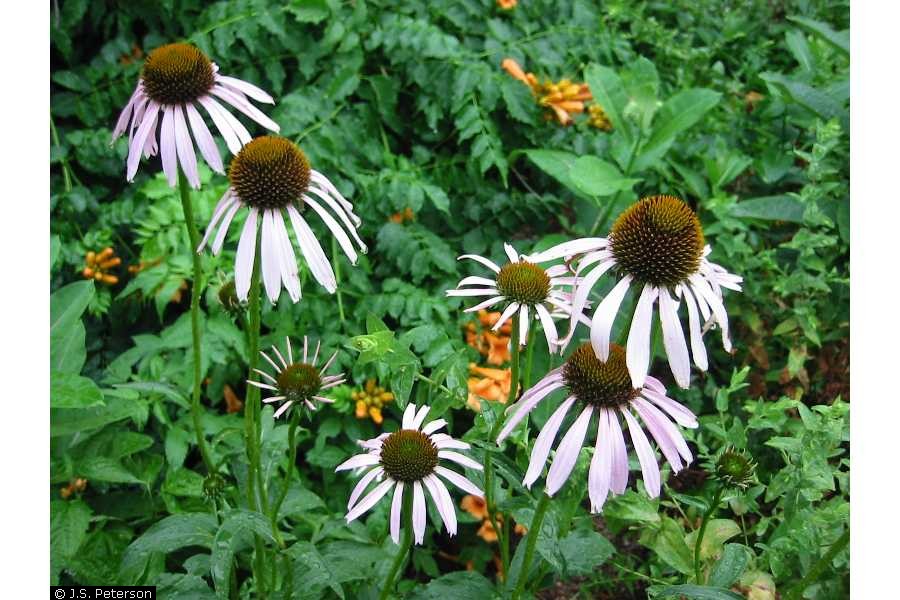Echinacea laevigata: Smooth Purple Coneflower
 Latin name: Echinacea laevigata
Latin name: Echinacea laevigata
Common name: Smooth Coneflower
Flowers: Showy pink/purple blooms in May, June, and July 10,13; flowers are typically 1-3inches 13
Fruit: Inconspicuous, tan seeds formed by the center disc flower 13
Height & Width: 3’h x 1-2’w 19
Type: Herbaceous perennial 10, 12,16
Habit: Upright, clumping form12
Wetland indicator category**: FACU17
Texture: Coarse4
Growth rate: Medium 4
Light: Full sun 13,19
Moisture: Medium 4,19
Soil*: Well-drained, clay or rocky, neutral on alkaline soils13
Zones: 4-8 4,12
Origin: Southeast United States (L48)16
Ecosystem benefits: Supports Wavy-lined Emerald (Synchlora aerata) larvae, visited by honey and native bees for its nectar, provides food for birds in the winter if seed heads remain13
Features: This flower is an endangered species with key traits that benefit wildlife10,13. The native flower provides showy summer blooms that work well in mass plantings or further back in planting beds, with a natural dear resistance4. The sturdy stems make the flowers great for cut flower production4,13.
Siting: Smooth coneflower can do well in mass plantings, perennial beds, or in naturalized environments4. This plant has a variety of uses ranging from growing as a wildflower in a meadow to a specialty crop in a cut flower garden13. Smooth coneflower prefers full sun and well-draining soil and can become drought tolerant after establishment19.
Care: Plant crown at soil level18. At planting, water the roots and surrounding area slowly and deeply. Keep soil moist until plant is established, then apply enough water to thoroughly moisten the root zone when the soil is dry or during drought. Modify water recommendations to reflect site drainage and rainfall. Apply 3” of mulch over the planted area. Do not allow mulch to touch the plant stems18. Deadheading old blooms will encourage new growth and result in a longer blooming season13.
Pests: Plants are relatively pest resistant if cultural preferences are met but Japanese beetles and leaf spot cause occasional problems13.
This plant does not appear on the following invasive plant lists on (10/9/22):
- X USDA SC Invasive Plant Species Web site at http://www.invasivespeciesinfo.gov/plants/main.shtml
- X SC Exotic Plant Pest Council Web site at http://www.se-eppc.org/southcarolina/
Author: Elizabeth Hudgens
Image source: https://bwwellsassociation.wordpress.com/2018/03/17/the-developmental-stages-of-the-smooth-coneflower-echinacea-laevigata/
Sources:
- Armitage, A. (2001). Armitage’s manual of annuals, biennials, and half-hardy perennials. Portland, OR: Timber Press.
- Armitage, A. (2006). Armitage’s native plants for North American gardens. Portland, Oregon: Timber Press.
- Armitage, A. (2008). Herbaceous perennial plants: A treatise on their identification, culture, and garden attributes. Athens, GA: University of Georgia.
- Clemson Cooperative Extension Home and Garden Information Center.(2011). Flowers fact sheets. Retrieved from https://hgic.clemson.edu/category/flowers/
- Clemson Cooperative Extension Home and Garden Information Center.(2011). Groundcovers & vines fact sheets. Retrieved from https://hgic.clemson.edu/category/groundcovers/
- Clemson Cooperative Extension Home and Garden Information Center.(2011). Trees. Retrieved from https://hgic.clemson.edu/category/trees/
- Clemson Cooperative Extension Home and Garden Information Center.(2011). Shrubs. Retrieved from https://hgic.clemson.edu/category/shrubs/
- Dirr, M. A. (2009). Manual of woody landscape plants. Champaign, IL: Stipes Publishing.
- Gilman, E. F. (1997). Trees for urban and suburban landscapes. Albany, NY: Delmar Publishers.
- Lady Bird Johnson Wildflower Center University of Texas at Austin. (2012). Native plant information network. Retrieved from http://www.wildflower.org/explore/
- McMillan, P., Plant taxonomist Clemson University, personal communication.
- Missouri Botanical Garden Kemper Center for Home Gardening. Plant finder. Retrieved from http://www.mobot.org/gardeninghelp/plantfinder/Alpha.asp
- North Carolina State University (2005). Plant fact sheets. Retrieved from http://www.ces.ncsu.edu/depts/hort/consumer/factsheets/index.html
- Strother, E. V., Ham, D. L., Gilland, L. (2003) Urban tree species guide: Choosing the right tree for the right place. Columbia, SC: South Carolina Forestry Commission.
- University of Florida, IFAS Extension. (2011). Southern trees fact sheet. Retrieved from http://edis.ifas.ufl.edu/department_envhort-trees
- USDA . Plant profile. (n/d).Retrieved from http://plants.usda.gov/java/
- USDA. Plant wetland indicator status. (n/d). Retrieved from http://plants.usda.gov/wetland.html
- Vincent, E., Environmental horticulturist Clemson University, personal communication.
- Clemson Extension. Carolina Yards Plant Database. Retrieved from https://www.clemson.edu/extension/carolinayards/plant-database/index.html
*Soil pH is determined using a professional soil test. Contact your Clemson University County Extension service for assistance www.clemson.edu/extension/. Click on “local offices”.
**2012 Plant Wetland Indicator categories (quantitative derived) http://plants.usda.gov/wetinfo.html
|
Indicator Code |
Indicator Status |
Comment |
|
OBL |
Obligate Wetland |
Almost always is a hydrophyte, rarely in uplands |
|
FACW |
Facultative Wetland |
Usually is a hydrophyte but occasionally found in uplands |
|
FAC |
Facultative |
Commonly occurs as either a hydrophyte or non-hydrophyte |
|
FACU |
Facultative Upland |
Occasionally is a hydrophyte but usually occurs in uplands |
|
UPL |
Obligate Upland |
Rarely is a hydrophyte, almost always in uplands |
 Latin name: Echinacea laevigata
Latin name: Echinacea laevigata
Common name: Smooth Purple Coneflower
Flowers: Purple to pink, showy and delicate drooping purple rays. Blooms June to August 12
Fruit: Not significant 13
Height & Width: 2-5’ x 1.5-2’ 12
Type: Herbaceous perennial 12
Habit: Upright, cascading, mound 16
Wetland indicator category**: No Wetland indicator was available for this plant.
Texture: Fine 16
Growth rate: Moderate 12
Light: Full sun to part shade 12
Moisture: Dry to medium 12
Soil: Tolerates clay soil, dry soil, shallow and rocky soil 12
Zones: 3-8 12
Origin: Southeastern United States 16
Note: This plant is on the United States threatened and endangered species list 16
Features: Beautiful, purple showy flowers are an attractive addition to a planting bed. The long-blooming flowers provide for longer color interest in the native plant garden. It can grow to be 2 to 5 feet tall, so placement must be made accordingly. Butterflies and other wildlife are attracted to the habitat this plant provides. 12
Siting: Easily grown in average, dry to medium, well-drained soil in full sun to part shade. Best in full sun. An adaptable plant that is tolerant of drought, heat, humidity and poor soil. Plants usually re-bloom without deadheading, however prompt removal of spent flowers improves general appearance. Freely self-seeds if at least some of the seed heads are left in place. 12
Care: Plant in suitable site with adequate soil organic matter so that the crown of the plant is at the soil surface 18. Ensure the soil is adequately moist immediately after planting. Keep soil moist but not soggy until plant is established. Once plant is established water deeply but infrequently whenever the soil surface is dry or almost dry 2” below the soil surface. 18
Pests: Plants are relatively pest resistant if preferences are met, but Japanese beetle and leaf spot are occasional problems.
Author: Whitney Blue Fraser, Editor: Alexander Smolka
Sources 1-18 found on Sources page
